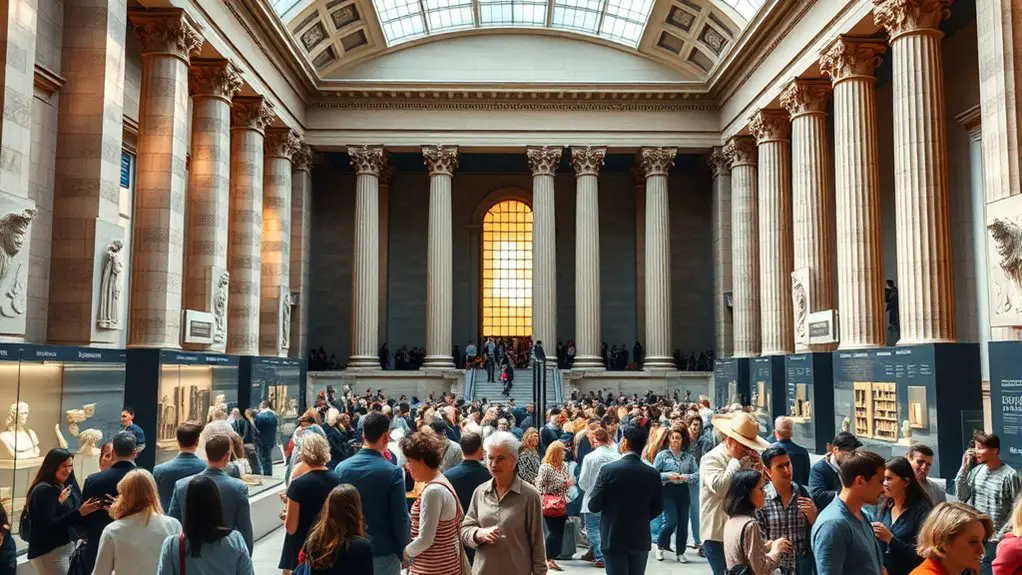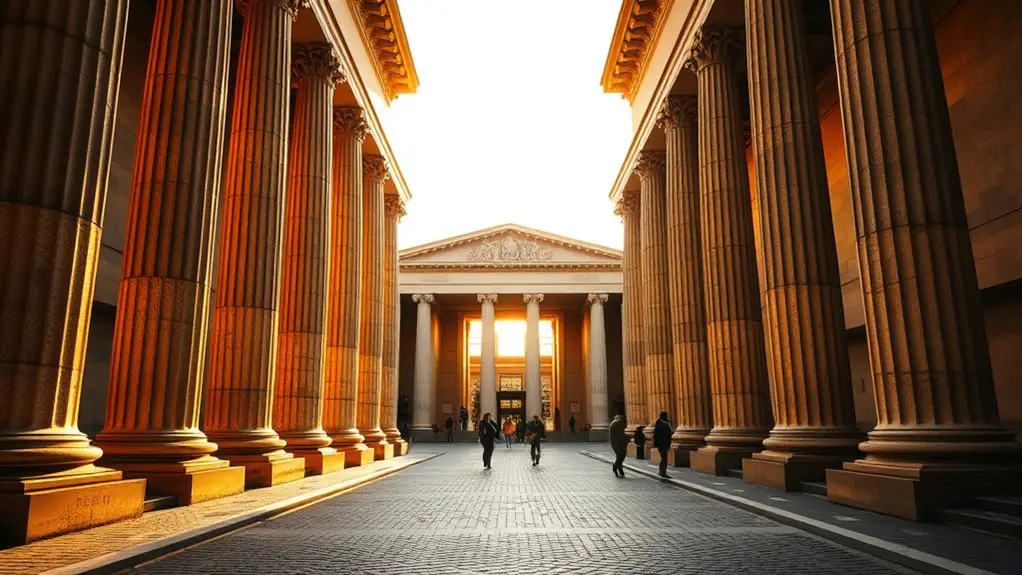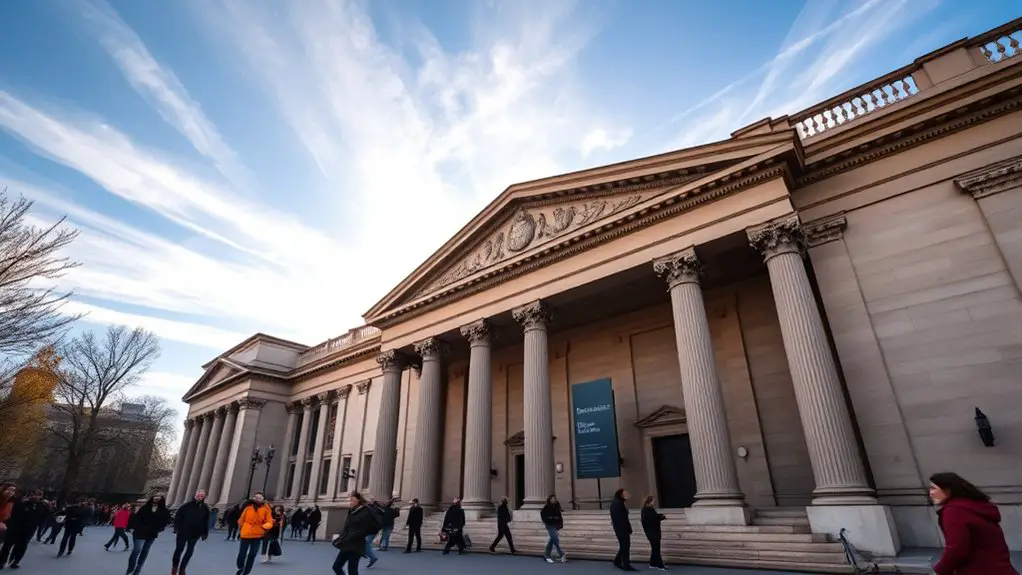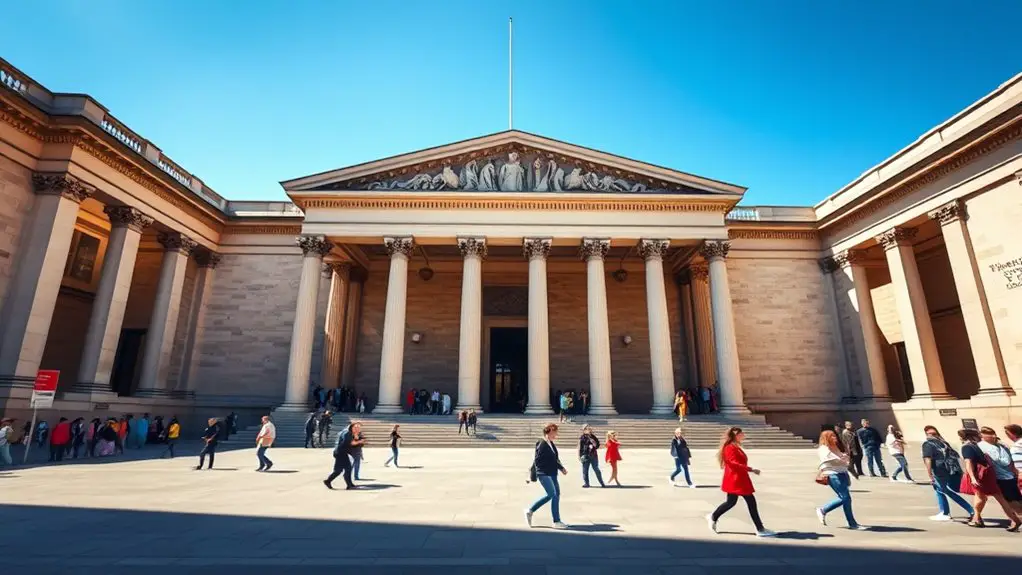The best time to visit the British Museum is on midweek mornings or late afternoons when crowds are thinner, giving you a more intimate and relaxed experience. Tuesdays through Thursdays typically see fewer visitors, especially early in the day. Avoid weekends and school holidays for quieter exploration. Weather also influences visitor flow, with fewer people showing up during bad weather. For more detailed tips on timing your visit for an ideal experience, keep exploring these insights.
Key Takeaways
- Visit Tuesday through Thursday mornings for fewer crowds and a more relaxed experience.
- Avoid weekends and major holidays, which attract larger, busier crowds.
- Plan your visit during off-peak months like late winter or early autumn for a quieter atmosphere.
- Arrive early in the day or late afternoon for a calmer, less crowded experience.
- Book tickets in advance, especially during special exhibitions or peak seasons, to secure entry and avoid long lines.
Best Days of the Week to Visit

To make the most of your visit to the British Museum, it’s best to choose the right days of the week. Generally, the best weekdays to visit are Tuesday through Thursday, as visitor patterns tend to dip on these days.
Mondays and weekends attract larger crowds, especially during school holidays and public events, which can make exploring less enjoyable. Midweek visits allow you to appreciate the exhibits with fewer people, giving you a more intimate experience.
Early mornings or late afternoons also tend to be quieter, but the lowest visitor numbers are often found during midweek mornings. Planning your trip on these days helps you avoid long lines and crowded galleries, ensuring you can fully immerse yourself in the museum’s rich history and stunning artifacts.
Optimal Times During the Day

Visiting the British Museum during specific times of the day can greatly enhance your experience, especially if you’re aiming to avoid crowds and enjoy a more relaxed exploration. Early mornings are ideal, as the museum is quieter, allowing you to immerse yourself in exhibits without interruption. Late afternoons also offer a calmer atmosphere, with fewer visitors lingering after peak hours. To visualize, consider this table:
| Time of Day | Experience |
|---|---|
| Early Morning | Quiet, fewer visitors, serene atmosphere |
| Late Afternoon | Calm, fewer crowds, reflective mood |
| Midday | Crowded, lively, busier environment |
| Early Afternoon | Moderate crowds, more energy |
| Evening (if open) | Tranquil, less crowded, ideal for deep focus |
Prioritize early morning or late afternoon visits to truly savor the museum’s treasures.
Seasonal Variations and Crowds

Seasonal changes greatly influence the crowds at the British Museum, with visitor numbers fluctuating throughout the year.
During peak seasons like summer and school holidays, crowd patterns intensify, often making galleries crowded and less intimate. Conversely, off-peak months such as late winter and early autumn tend to see fewer visitors, allowing for a more immersive experience.
Understanding seasonal trends helps you plan your visit to avoid the busiest times, especially if you value a quieter atmosphere.
Knowing seasonal trends helps you visit when the museum is less crowded for a more peaceful experience.
Spring and early summer often bring moderate crowds, while major holidays and weekends attract larger groups. By aligning your visit with these crowd patterns, you can enjoy exhibits more comfortably, appreciate the museum’s masterpieces without distraction, and truly immerse yourself in its rich history.
Special Events and Exhibition Schedules
Special events and temporary exhibitions greatly influence the British Museum’s busiest days and overall visitor flow. When planning your visit, consider the museum’s schedule of special exhibitions and event highlights, which often draw larger crowds and create unique opportunities to experience rare artifacts.
These events typically include themed exhibitions, anniversary celebrations, or international loan displays, offering fresh perspectives on familiar collections.
Here are key points to keep in mind:
- Major special exhibitions are usually announced months in advance, so plan accordingly.
- Event highlights, such as curator-led tours or special talks, occur periodically.
- Peak attendance often coincides with opening days of new exhibitions.
- Visiting during quieter periods between events can provide a more intimate experience.
Holidays and Peak Tourist Seasons
Visiting during major holidays and peak tourist seasons means battling large crowds and long lines, which can diminish your museum experience.
Opting for weekdays often provides a quieter, more intimate atmosphere, allowing you to appreciate the exhibits fully.
Additionally, exploring during the off-season can grant you access to special offers and fewer visitors, making your visit both enjoyable and economical.
Avoid Peak Holiday Crowds
To experience the British Museum without the overwhelming crowds, it’s best to plan your visit outside major holiday periods and peak tourist seasons.
During these times, crowd management becomes challenging, often diminishing your visitor experience. To avoid this, consider visiting:
- Early mornings on weekdays, when crowds are minimal
- Late afternoons, especially during off-peak seasons
- During school terms, avoiding holiday breaks
- Outside major events or exhibitions that draw large crowds
Weekday Visits Are Quieter
Weekday visits tend to be considerably quieter during holidays and peak tourist seasons, making them the ideal time to explore the British Museum without the usual crowds.
During these times, you’ll experience weekday tranquility that allows for a more intimate connection with the exhibits. The museum atmosphere shifts from bustling to contemplative, enabling you to appreciate intricate artifacts and detailed displays without distraction.
Fewer visitors mean you can spend more time at each exhibit, reading descriptions, and truly absorbing history. This calmer environment enhances your overall experience, fostering a deeper appreciation for the museum’s vast collection.
If you value serenity and focused exploration, visiting on a weekday during quieter periods offers the best opportunity to enjoy the British Museum at its most peaceful.
Off-Season Offers Available
During holidays and peak tourist seasons, the British Museum often offers special off-season deals that can greatly enhance your visit.
These off season discounts provide significant savings and improved visitor benefits, making your experience more enjoyable and accessible.
Take advantage of fewer crowds and exclusive offers by planning your trip during these times.
Consider these key benefits:
- Lower admission costs with off season discounts
- Shorter lines and more personalized attention
- Enhanced access to popular exhibits without the rush
- Better opportunities for in-depth exploration and photography
Tips for Visiting During School Holidays
Visiting during school holidays requires careful planning to make the most of your experience.
Booking tickets early helps you avoid disappointment, as the museum gets crowded quickly.
Be prepared for longer visits and allocate extra time to fully appreciate the exhibits without feeling rushed.
Book in Advance
- Reserve your tickets early online to avoid last-minute sellouts.
- Look for special offers or discounts available for advance bookings.
- Choose off-peak times when fewer visitors are expected, maximizing your experience.
- Confirm your reservation to prevent any entry issues on the day of your visit.
Expect Crowds
School holidays often bring a surge of visitors to popular attractions like the British Museum, making it important to plan your visit accordingly.
During these peak times, expect crowded galleries and bustling corridors, which require effective crowd management. To enjoy the museum fully, stay patient and be mindful of visitor behavior—avoid blocking exhibits or obstructing pathways.
Consider arriving early or later in the afternoon to escape the heaviest crowds. Keep your group close, and move deliberately through the exhibits to minimize congestion.
Recognizing that fellow visitors are also keen to experience the museum helps foster respectful behavior. With thoughtful planning and awareness, you can navigate the busy periods smoothly, ensuring your visit remains enjoyable despite the increased crowds.
Plan for Longer Visits
Since school holidays typically draw larger crowds, planning for a longer visit to the British Museum guarantees you can thoroughly explore its treasures without feeling rushed.
To maximize your experience during busy periods, consider these tips:
- Join guided tours, which help you navigate crowded spaces efficiently and gain expert insights.
- Allocate extra time for extended exhibits, ensuring you don’t miss key artifacts and displays.
- Visit early in the morning or late in the afternoon to avoid peak crowds.
- Prepare a detailed plan, focusing on your must-see sections to make the most of your extended visit.
How Weather Affects Visitor Numbers
Weather conditions greatly influence visitor numbers at the British Museum, as favorable weather encourages more people to venture outdoors and explore cultural sites.
Weather patterns such as sunshine, mild temperatures, and clear skies naturally boost visitor behavior, leading to increased crowds, especially during spring and summer. Conversely, rainy or cold days tend to deter casual visits, reducing overall foot traffic.
You’ll notice a dip in visitors during harsh weather, making these times ideal for quieter exploration. Understanding how weather impacts visitor flow helps you plan your visit strategically.
When the weather is pleasant, you’ll enjoy a lively, bustling atmosphere. On less favorable days, it’s easier to appreciate exhibits without the crowds.
Weather truly shapes the museum’s visitor dynamics, influencing your experience.
Planning Around Major Museum Events
Planning your visit around major museum events can greatly enhance your experience, offering opportunities to see exhibit openings, attend exclusive talks, or participate in themed activities.
By aligning your trip with key dates, you gain access to unique programs and behind-the-scenes insights. To maximize your visit, consider these points:
Align your visit with key dates to unlock exclusive programs and behind-the-scenes insights.
- Check the museum’s event scheduling for upcoming exhibit openings that showcase new artifacts or themes.
- Attend special talks by curators during major exhibitions for a deeper understanding.
- Participate in themed activities or workshops tied to current or upcoming displays.
- Visit during quieter periods around major events to enjoy a more intimate experience.
Staying informed about event scheduling guarantees you don’t miss out on the museum’s most exciting offerings and enriches your overall visit.
Frequently Asked Questions
Are There Any Days When the British Museum Offers Free Guided Tours?
You’ll find that the British Museum offers free guided tours on select days, with schedules occasionally changing throughout the year.
To catch these, check their official website for up-to-date free tour schedules and guided tour availability.
These tours provide insightful, passionate explanations of exhibits, enhancing your experience.
How Early Should I Arrive to Avoid the Largest Crowds?
To avoid the largest crowds, arrive early in the morning when the museum opens, typically around 10 am.
Crowd patterns are lighter then, especially during weekdays, before peak hours hit midday and late afternoon.
Visiting early allows you to enjoy exhibits more peacefully and fully immerse yourself in the history and art.
Be punctual; early visits make for a more relaxed, enriching experience free from the bustling peak hours.
Is There a Best Time to Visit for Avoiding Museum Closures or Maintenance?
You should check the British Museum’s schedules before planning your visit to avoid closures or maintenance.
Museum schedules vary, especially during holiday closures like Christmas and New Year’s, when the museum often shuts for several days.
To guarantee you experience the museum fully without interruptions, visit during weekdays outside peak holiday seasons.
Staying informed about scheduled maintenance and special events helps you choose the best time for an uninterrupted, enriching visit.
Do Special Exhibitions Impact Visitor Numbers Significantly?
Special exhibitions notably impact visitor numbers at the British Museum by boosting visitor engagement, drawing both new and returning visitors.
These exhibitions often showcase rare artifacts and thematic displays, creating a sense of urgency and excitement.
When you attend during these times, you experience a more dynamic, immersive visit.
Planning your trip around such exhibitions can enrich your experience and guarantee you don’t miss out on some of the museum’s most enthralling displays.
Are There Specific Times When Certain Galleries Are Less Crowded?
If you want to avoid crowds, consider visiting during off-peak hours or weekday visits.
Early mornings and late afternoons typically see fewer visitors, especially on weekdays.
Certain galleries, like the Egyptian or Greek sections, tend to be less crowded during these times.
This allows you to explore more intimately, appreciate the exhibits with less distraction, and enjoy a more passionate, detailed experience of the museum’s treasures.
Conclusion
To make the most of your visit to the British Museum, plan thoughtfully around quieter days and ideal times, considering seasonal peaks and special events. By avoiding peak holidays and school breaks, you’ll enjoy a more intimate experience with its incredible exhibits. Keep an eye on weather and major event schedules to enhance your visit. With careful planning, you’ll uncover the museum’s treasures in a more relaxed, enriching way—turning a trip into a truly memorable adventure.
